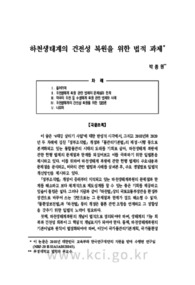

PARTNER
검증된 파트너 제휴사 자료
하천생태계의 건전성 복원을 위한 법적 과제 (Legal Issues in Restoring the Health of the River Ecosystem)
55 페이지
최초등록일 2025.03.18
최종저작일
2021.04

-
미리보기
서지정보
· 발행기관 : 한국환경법학회
· 수록지 정보 : 환경법연구 / 43권 / 1호 / 271 ~ 325페이지
· 저자명 : 박종원
초록
이 글은 ‘4대강 살리기 사업’에 대한 반성적 시각에서, 그리고 2018년과 2020년 두 차례에 걸친 「정부조직법」 개정과 「물관리기본법」의 제정・시행 등으로 본격화되고 있는 통합물관리 시대의 도래를 기회로 삼아, 하천생태계 복원에 관한 현행 법제의 문제점과 한계를 되짚어보고 이를 극복하기 위한 입법론을 제시하고 있다. 이를 위하여 하천생태계 복원에 관한 현행 법제의 주요내용과 문제점을 분석하고, 미국의 관련 법령과 사례를 살펴본 후, 주요 쟁점별로 입법적 개선방안을 제시하고 있다.
「정부조직법」 개정이 종래부터 지적되고 있는 하천생태계복원의 문제점과 한계를 해소하고 보다 체계적으로 제도설계를 할 수 있는 좋은 기회를 제공하고 있음이 틀림은 없다. 그러나 지금과 같이 「하천법」상의 국토교통부장관을 환경부장관으로 바꾸어 쓰는 것만으로는 그 문제점과 한계가 결코 해소될 수 없다. 「물환경보전법」과 「하천법」 등의 개정은 물론 관련 조항을 연계하고 그 정합성을 갖추기 위한 입법적 노력이 필요하다.
첫째, 하천생태계복원의 개념이 법적으로 정의되어야 하며, 생태계의 기능 회복과 건전성 회복이 그 핵심적 개념표지가 되어야 한다. 둘째, 하천생태계복원의 기본이념과 원칙이 법정화되어야 하며, 이것이 국가물관리기본계획, 국가물환경관리기본계획, 하천기본계획, 그리고 수생태계복원계획으로 연계되고 구체화될 수 있어야 한다. 셋째, 누가 복원사업을 실시하든 법령상의 일정한 기준대로 복원계획을 수립하여야 하며, 그 절차 가운데 지역주민, 시민단체, 전문가 등이 주도적으로 참여할 수 있어야 한다. 넷째, 수생태계 현황 조사 및 건강성 평가나 수생태계 연속성 조사 등의 결과를 토대로 하천생태계복원이 시급히 요구되는 복원대상지역목록을 작성・공표하도록 함으로써, 복원사업의 추진이나 비용지원 등에 관한 판단기준으로 삼아야 한다. 다섯째, 훼손 상태가 심각한 것으로 판단되거나 우선복원대상 하천생태계목록상 일정 순위 이내에 포함된 하천에 대해서는 수생태계복원계획의 수립을 의무화하고, 복원계획의 승인을 위한 요건으로 복원목표의 설정에서부터 설계, 복원사업의 시행, 사후모니터링 및 사후관리 등 각 단계에 관한 기준이 보다 구체화되어야 한다. 나아가 사업단계에서의 정기적인 보고, 사업완료 이후의 추진실적 제출과 평가, 사후모니터링과 사후관리에 관한 점검 등을 제도화하고, 그 실적평가나 점검 결과에 따라 비용지원, 시정명령 등이 가능하도록 함으로써 그 실효적인 이행을 확보하여야 한다. 여섯째, 국가하천이든 지방하천이든 그 생태계는 연결되어 있는 것이므로 복원사업의 재원을 지방보조금에 의존할 것이 아니라 국가 차원에서 그 비용을 지원할 수 있는 근거를 마련하여야 하며, 하천생태계의 훼손에 보다 직접적으로 관여해온 원인자에 대한 부담금 등을 복원사업의 재원으로 할 수 있도록 하여야 한다.
이상의 개선점 중 다수는 「물환경보전법」 개정을 통하여 달성가능하나, 「하천법」이나 「물관리기본법」의 개정도 수반되어야 한다. 하천생태계복원의 기본이념이나 원칙이 관련 계획으로 적정하게 연계될 수 있기 위해서는 「물관리기본법」 개정을 통하여 「하천법」상의 하천기본계획 등이 국가물관리기본계획과의 부합 여부에 대한 심의대상으로 명시되어야 할 것이며, 「하천법」상 하천관리청이 하천기본계획을 수립함에 있어서 복원지구 등을 지정하는 경우 우선복원대상 하천생태계목록을 고려하도록 의무화할 필요가 있다. 또한, 「하천법」에는 하천기본계획상의 복원지구 등의 지정에 관한 사항만을 남기고, 복원계획 수립 및 시행에 관한 사항은 「물환경보전법」으로 일원화하는 방안이 적극 고려되어야 한다.영어초록
Reflecting on the failure of the Four Major Rivers Restoration Project, and welcoming the era of integrated water management, this article presents a legislative solution to restore the health of the river ecosystem. To achieve this, this article examined the problems and limitations under the current legal system. It also analyzed some laws and programs on the restoration of the aquatic ecosystem in the United States, aiming to obtain some lessons from them.
The revised Government Organization Act of 2020 certainly provides a good opportunity to solve the chronic problems and limitations of the legal system of river ecosystem restoration. However, merely replacing the Minister of Land, Infrastructure and Transport with the Minister of Environment under the current River Act can never address these issues. More legislative efforts are required to link related provisions of the Water Environment Conservation Act, the River Act, the Framework Act on Water Management, and so on and ensure their mutual consistency.
Based on these analyses, this article suggests several legislative alternatives to improve the legal system of river ecosystem restoration. First, the concept of river ecosystem restoration should be legally defined with the restoration of the ecological function and health as key elements. Second, the basic ideas and fundamental principles of river ecosystem restoration should be incorporated into the law, which can be linked and embedded in several related administrative plans, including the National Water Management Master Plan, the National Water Environment Management Master Plan, the Basic River Plans, and the Aquatic Ecosystem Restoration Plans. Third, no matter who conducts the restoration project, the restoration plan should be established in accordance with legal criteria, and opportunities for participating in each stage of the restoration project should be guaranteed to interested parties, including the local community, NGOs, and experts. Fourth, based on the results of the current status and health assessment of aquatic ecosystems, or the examination of the continuity of aquatic ecosystems, the priority list of sites for restoration should be prepared and published and should be used as the basis for determining whether to implement the restoration project or provide financial support for it. Fifth, for sites whose ecosystems have been degraded severely or which are highly ranked in the priority list, it should be mandatory to establish their restoration plans and the requirements for their approval should be further specified, including the criteria on setting goals, designing and conducting the project, postmonitoring, and postmanagement. Furthermore, regular reporting at the stage of conducting the project, performance evaluations after project completion, and postmonitoring and postmanagement inspection should be institutionalized. And the results of the evaluation or inspection can be used as a basis whether or how much to provide financial support for the project and whether to issue the correction order to ensure effective enforcement. Sixth, the law should state that the national government can provide financial support to the restoration project, whether it is performed on a national or regional river, as all rivers are ecologically connected and interact with one another. Also, charges incurred by persons who have been more directly involved in the ecological degradation of the river ecosystem should be used as financial resources for conducting the restoration project.
Many of these solutions can be achieved by revising the Water Environment Conservation Act, but the revisions of the River Act and the Framework Act on Water Management should also be included. For the fundamental principles of river ecosystem restoration to be properly linked to relevant plans, the Basic River Plan under the River Act should be reviewed whether it conforms to the National Water Management Master Plan. The river management agency must also be required to consider the priority list when it designates restoration sites under the Basic River Plan. In addition, it should be positively considered that the River Act shall address only the designation of restoration sites under the Basic River Plan, and the stage of establish the restoration plan and subsequent steps shall be covered by the Water Environment Conservation Act.참고자료
· 없음태그
- # Ecological Restoration
- # River Ecosystem Restoration
- # Ecological River Restoration Project
- # Four Major Rivers Restoration Project
- # Integrated Water Management
- # Water Environment Conservation Act
- # River Act
- # Framework Act on Water Management
- # Small River Maintenance Act
- # 생태계복원
- # 하천생태계복원
- # 생태하천복원사업
- # 4대강살리기사업
- # 통합물관리
- # 물환경보전법
- # 하천법
- # 물관리기본법
- # 소하천정비법
-
자주묻는질문의 답변을 확인해 주세요

꼭 알아주세요
-
자료의 정보 및 내용의 진실성에 대하여 해피캠퍼스는 보증하지 않으며, 해당 정보 및 게시물 저작권과 기타 법적 책임은 자료 등록자에게 있습니다.
자료 및 게시물 내용의 불법적 이용, 무단 전재∙배포는 금지되어 있습니다.
저작권침해, 명예훼손 등 분쟁 요소 발견 시 고객센터의 저작권침해 신고센터를 이용해 주시기 바랍니다. -
해피캠퍼스는 구매자와 판매자 모두가 만족하는 서비스가 되도록 노력하고 있으며, 아래의 4가지 자료환불 조건을 꼭 확인해주시기 바랍니다.
파일오류 중복자료 저작권 없음 설명과 실제 내용 불일치 파일의 다운로드가 제대로 되지 않거나 파일형식에 맞는 프로그램으로 정상 작동하지 않는 경우 다른 자료와 70% 이상 내용이 일치하는 경우 (중복임을 확인할 수 있는 근거 필요함) 인터넷의 다른 사이트, 연구기관, 학교, 서적 등의 자료를 도용한 경우 자료의 설명과 실제 자료의 내용이 일치하지 않는 경우
“환경법연구”의 다른 논문도 확인해 보세요!
-
국제법상 생태계기반 접근법의 지위에 관한 소고 33 페이지
전 세계가 전례 없는 어업위기에 직면하고 있는바 국가관할권 이원지역(Areas Beyond National Jurisdiction)의 해양생태계를 고려한 광범위한 보존조치의 채택이 요구되고 있다. 국제사회는 2004년부터 국가관할권 이원지역의 해양생물다양성(Biodiversity in Areas Beyond National Jurisdiction, BBNJ.. -
통합물관리를 위한 법제 정비방향 35 페이지
물관리일원화 내지 통합물관리는 물관리 법체계상 종전과 다른 패러다임의 전환을 요구하고 있다. 그럼에도 불구하고 물관리일원화를 기치로 물관리 3법이 만들어지고 그로부터 3년 정도 지난 이 시점에도 일정 부분 물관리 기능이 환경부로 소관 부처가 변경되었을 뿐 실체적 규정 내용이 종전과 크게 다르지 않은 것은 정부의 물관리일원화에 대한 의지와 능력이 있는지를 의..
찾으시던 자료가 아닌가요?
지금 보는 자료와 연관되어 있어요!
문서 초안을 생성해주는 EasyAI


